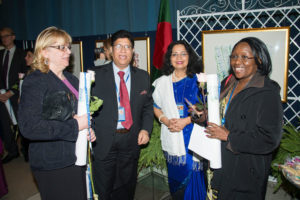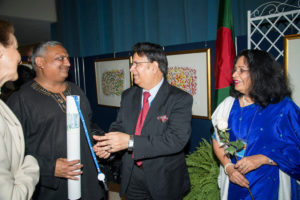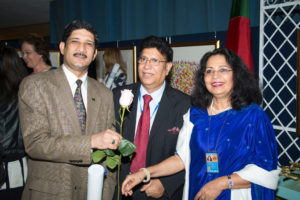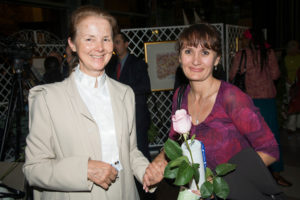
H.E. Ambassador Abulkalam Momen, Permanent Representative of Bangladesh to the UN, hosts the opening reception of Paintings for World-Harmony.
Sri Chinmoy’s Paintings for World Harmony were on display in the UN General Assembly Building, in the prestigious exhibit space of the Delegates Entrance, from 15 to 26 October 2012. The exhibition was dedicated to a Culture of Peace and was cosponsored by the Permanent Mission of Bangladesh to the UN; the Jharna-Kala Art Foundation; and Sri Chinmoy: The Peace Meditation at the United Nations. As noted in the exhibit brochure, the display endeavoured to “enrich other’s lives through the beauty of art and in so doing, to promote the ideals of peace, compassion, benevolence, non-violence, oneness and human understanding, which are so fundamentally necessary for humankind’s peaceful co-existence.”
Special Guest Archbishop Desmond Tutu
The first guest to visit the Exhibit was Archbishop Desmond Tutu, who took time out of his busy schedule to view the paintings on 14 October, the day before the official opening. See more details of his visit.

Archbishop Desmond Tutu visits the Paintings for World-Harmony for a preview of the Exhibit.
Opening Reception
The Opening Reception on 15 October 2012 was kindly hosted by H.E. Ambassador Abulkalam Abdul Momen, Permanent Representative of Bangladesh, and attended by many delegates and staff and their guests, including curators from local museums. Following are excerpts from remarks offered at the event.

H.E. Ambassador Abulkalam Abdul Momen, Permanent Representative of Bangladesh to the UN: Excellences, distinguished colleagues and friends, thank you for joining us today for the opening at the United Nations of the exhibit “Paintings for World-Harmony” by artist Sri Chinmoy, dedicated to a culture of peace as expressed through the arts. Bangladesh has always been one of the main promoters of a Culture of Peace, both here at the United Nations and elsewhere. Tonight we are very proud to present the work of a beloved son of Bengal, Sri Chinmoy. For decades he offered the Bengali culture-light to music and art lovers around the world, inspiring many to learn songs he had composed in our native tongue. The members of the instrumental group we have just heard, for example, hail all the way from Switzerland, yet have been performing his songs in Bangla, the sixth largest native speaking language of the world.
For over 37 years Sri Chinmoy graced the august halls of the United Nations. In 1970 then Secretary-General U Thant invited Sri Chinmoy to lead twice-weekly peace meditations for delegates and staff at UN Headquarters in New York, which he did until his passing in 2007. These meditations and other activities of Sri Chinmoy: The Peace Meditation at the United Nations, continue to this day. Indeed, since the first Bangladesh-sponsored resolution and the UN General Assembly’s adoption in 1999 of the Declaration and Programme of Action for the Culture of Peace, there have been several of his exhibits here at the UN supporting this important initiative, as many of you may remember. And I can think of no better place for his art to be displayed than here at UN Headquarters, the hub of international affairs and diplomacy, serving as a reminder of our firm and resolute commitment to global peace. Bangladesh is one of the top troop contributing countries of the world that allows men and women under the UN flagship to help promote and stabilize peace across nations.
Although we Bengalis claim Sri Chinmoy as our own, his message is global in scope. In fact, I first became acquainted with his spiritual philosophy when I was teaching at Harvard University, where he often lectured and gave concerts. I came to know some of his devotees who were working at the Harvard, MIT, Boston and Northeastern University Libraries, that house an extensive collection of his books and music. From University classrooms to United Nations conference rooms, Sri Chinmoy inspired many with his illuminating vision of love. He was an ardent believer in the founding principles and goals of this world body. In his own words: “The outer message of the United Nations is peace. The inner message of the United Nations is love. The inmost message of the United Nations is oneness.”
Peace, love, oneness and many other divine qualities radiate from these beautiful paintings. In a very tangible way, their silent beauty speaks to us, perhaps more powerfully than any words, to continue striving for a Culture of Peace, in our own lives and in the world at large. A Culture of Peace believes that all wars and misunderstanding and violence emanate from a mindset of hatred, ignorance and intolerance. By inculcating a mindset of tolerance, love, diversity and love for others, we can overcome wars and threats.
In this spirit, I encourage all of you this evening to enjoy the artwork, the music and the blessings of a great cultural ambassador of Bangladesh and a true universal ambassador of peace, Sri Chinmoy.

Ambassador Davidson Hepburn, President of the UNESCO General Conference (2009-2011); Permanent Representative of the Bahamas (1978-1989): I am most pleased to be here in New York again, and especially in this house that stands as a symbol of the aspirations for peace and harmony among all peoples of the world. I had the privilege to introduce the Peace and World Harmony Run in my country, the Bahamas, in 2010. In conjunction with the Run, the World Harmony Paintings were exhibited at the Governor General’s Residence, and while viewing them I felt very special indeed. I felt a sense of peace, a sense of joy. I noted at the time that, when we first looked at the paintings, in addition to the wonderful sense of colour, we also noticed what appear to be clashes. But for me and many others, the paintings represented something higher, something bigger: they represented the coming together of individuals and culture, just as we have in this building.
The paintings seem to express the many different ways of being in the world, the varied philosophies, beliefs, talents and other unique aspects of human life. It is a real achievement when we can encourage and appreciate uniqueness and at the same time, celebrate our oneness. I would like to make a reference here to a similar concept of a Bahamian artist, who was very spiritual, the late Amos Ferguson, a man who produced hundreds of paintings on various aspects of nature and life. Despite the lack of recognition in the early years, he persisted and now his paintings are permanently exhibited in the National Art Gallery in the Bahamas.
Our differences have tremendous potential to expand our collective capacity and deepen our understanding of what it truly means to be a member of a global family. Sri Chinmoy, the artist, often said he followed a streak of light as he painted. As we view these paintings, we can see the many bold strokes of colour. We can feel the special energy that emanates from each painting as it dynamically harmonizes diverse and vibrant elements.
The goal of ‘oneness,’ as Sri Chinmoy called it, is really the goal of our wonderful international organizations: To express that oneness, we need peace. I was my country’s Ambassador and Permanent Representative for many years here at United Nations Headquarters. And even with a demanding schedule, I was at times able to attend the peace meditations in this very building, led by Sri Chinmoy. The peace I experienced during those sessions energized me in my work. It was one of the best decisions I could have ever made.
UNESCO, where I recently served as President of the General Conference, and the other UN organizations are doing something most striking for the world, But we do need on a regular basis to be reminded of the fundamental goal we are striving for: a shared sense of belonging on this planet, and a strengthening of the values that will enable us to live together peacefully and creatively. My dear friends, we need inspiration, we need dynamic energy, we need joy that will always open our hearts —and that is what the peace of these World Harmony Paintings offer. Such is the power of art. When we develop more ways for people to experience the feeling of ‘oneness,’ I believe we will have more of the peace and harmony that we are all seeking — for ourselves, for our global community and especially for the generations that will come after us. With the conviction that we are one, in all our splendid diversity, we will more easily find creative solutions to the main challenges we face.
Let us keep in mind that spark of inspiration that originally brought us to the United Nations. That is still the reason that we are here. Let us take time to be together in silence for a few minutes of reflection. Let us find opportunities to reach out to our colleagues in our own countries and in other countries, especially through art and through culture. And let us continue. As Sri Chinmoy wisely said, as he demonstrated in his own life, even if the progress of our world seems slow, we must never give up.
For over forty years, the Peace Meditation Group at the United Nations has been creating opportunities for us to come together. Led by Sri Chinmoy, we were invited not only to regularly pray and meditate silently for peace, but also to celebrate special occasions with music, art and poetry. I encourage the members of the Peace Meditation Group here at the United Nations to continue to inspire the international community. Through your creative events and your beautiful programmes, you help us to renew our inner commitment to the highest aspirations of the UN Charter.
: 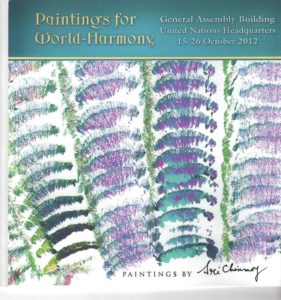
Above is the cover of the brochure for the Exhibit, Paintings for World Harmony.
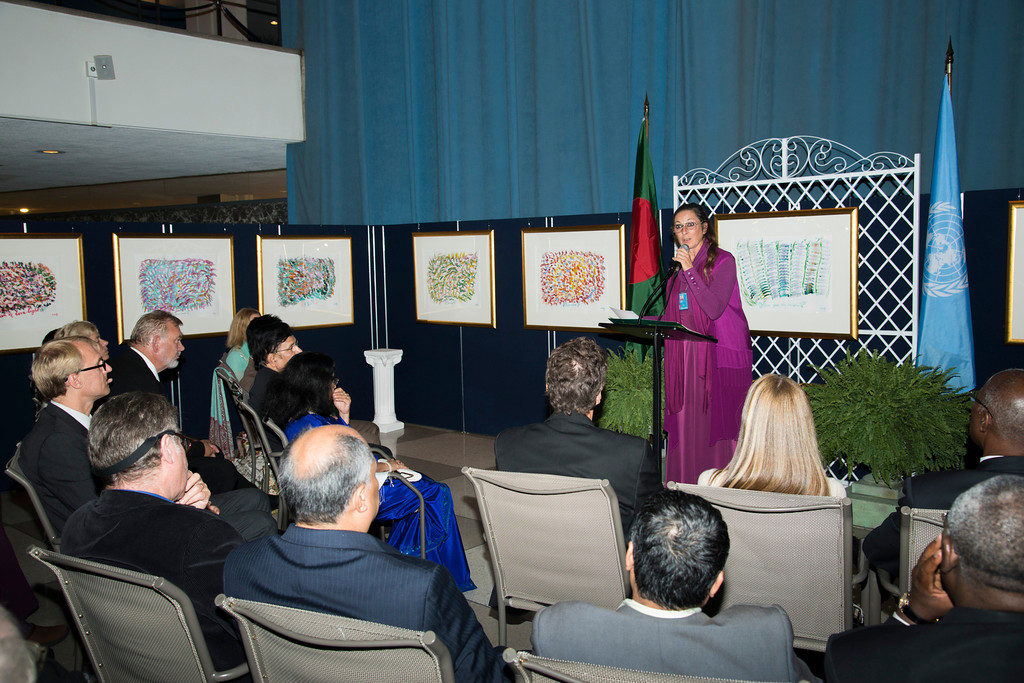
Ms. Ranjana Ghose, Curator and Director of the Jharna-Kala Art Foundation: We thank you so very much, Ambassador Momen, for hosting this exhibition. It gives an opportunity to do again what is dearest to our heart, and that is to bring some form of peace to other people and to ourselves. We feel very happy to have these paintings as a great source of energy and peace, and a reminder of finer ideals. These paintings are for world harmony, these paintings are for peace by artist Sri Chinmoy. His signature CKG soul birds or peace birds have been artistic endorsement for world peace for decades.
Sri Chinmoy’s art embodies the message of world peace, “Harmony”, “Brotherhood”, ”Protection of Nature”, “Compassion”, “Benevolence”, Non-Violence” and an aspiration for a more concerned humanity.
In using the genre to help culture peace in the self and in the world, Sri Chinmoy created paintings with an inspired dedication, surely in hopes of enkindling awareness and strengthening a progress toward that concern in fellow world-citizens. In that sense, what better way for the exhibit to have begun its journey than here at the United Nations itself. … The varying intensities of each piece translate into a dynamic non-violence; and populations of radiant colours coexist in a glowing tolerance of each other: A microcosm of an ideal humanity. … in so many of the works, as in “Heart-Garden”, “Nature’s Beauty”, “Delight” and “Benevolence” we see the use of colours which spontaneously energizes us with the more positive qualities of life.
In 2001 Sri Chinmoy had decided to do a Series of 70 Paintings all dedicated to Peace.…He would himself be turning 70, and he wanted to rededicate his life works to peace….The year before in 2000, the UN General Assembly had declared 2000 the International Year for a Culture of Peace, and subsequently the General Assembly declared 2001-2010 as the International Decade for a Culture of Peace and Non-Violence for the Children of the World. These initiatives were spearheaded by then Bangladesh Ambassador Anwarul Chowdhury, who also hosted Sri Chinmoy’s exhibits at the UN in 2000 and 2001. So it is so appropriate that now, over 10 years later we have the same exhibition of paintings which was originally dedicated to world peace in 2001 hosted again by the Bangladesh Mission to the UN, and we are very grateful for that and feel that it is significant….
Through the paintings of World Harmony exhibition, Sri Chinmoy has offered his art in many different public spaces as possible so that these messages of world brotherhood might be viewed, received and shared by brothers and sisters of humanity from all over the world, from all walks of life. His paintings of world harmony and peace exhibited in various city halls, in cities such as San Francisco, Oslo, Tokyo, and Reykjavik; in International Airports such as O’Hare in Chicago, JFK and La Guardia here in New York, Newark Airport and other airports around the world. They also travelled to statehouses such as Boston, Massachusetts and Canberra, Australia, as well as the Jacob Javits Convention Center right here in New York and the Carrousel du Louvre in Paris.
Interestingly, one can see that the paintings for world harmony are an attempt to bring art out of the Museums and to the public, so that it may affect the public, thus helping to cultivate a climate of
peace. We know so well, that due to the harried pace of today’s lifestyles, many do not frequent the museums and places of fine culture as often as they might wish. Yet the culturing of our finer selves
is something which we value greatly and rightly so… In the paintings for World Harmony exhibitions we attempt to nurture this need for higher culture in ourselves and in others, by bringing art and the higher values of civilization into varied and diverse venues. You may ask why Peace through art? But what greater and more appropriate role could art play. Art itself, like humanity, thrives best in the climate of peace. And art, like humanity and like children of humanity, perishes as a result of war and intolerance. As art is a child of our heart that must be nurtured, nourished and cared for, the child of humanity must also be nurtured and cared for, as a child of our own heart. The world is crying to each one of us for help. And surely when we help the world, we will certainly help ourselves. For are we not the world? We, all united as brothers
and sisters of humanity.
Thank you all for coming to this exhibition. We are honoured by your presence and we are proud to be of any humble service to you by presenting these artworks of the noble Sri Chinmoy who truly
embodied these very qualities for us, which is why we continue to be inspired by them. We hope that in some way they will bring you inspiration, and you in turn will pass your inspiration on to others. For you are the very people, the arms of the UN body that carry that inspiration and those ideals into the physical world so that the rest of humanity can benefit from that. I thank you.
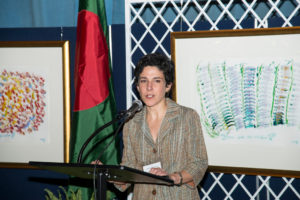
Ms. Jacqueline Terrassa, Managing Museum Educator for Gallery and Studio Programs at the Metropolitan Museum of Art: I want to begin with a question that I was asked to address tonight: “What do art museums do to contribute to world peace and cultural understanding?” If I went around the room all of you would have a variety of different answers or perhaps you would stare at me somewhat blankly. But I think it is a very, very important question, It really is at the heart of what we do every day at the museum; in our education programs; and at the heart of why the Metropolitan Museum was founded.
And week after week families learn about Art and life of civilizations close to them and far away from them as they explore the museum during our free programs. During these programs children and their adult companions practice the art of slowing down, of noticing more closely and asking questions about what they see. I hope that they leave the museum more curious and with a bigger picture of the world than when they arrived.
The kinds of challenges you address every day on a global scale; from political crises, to hunger, to housing for refuges; and the kinds of dilemmas, joys and questions that each of us pose to ourselves every day as we go about our lives: these are the reasons we need our museums, such as the MET. We need places for encounter, for inspiration and for reflection.
The MET opened 140 years ago, as an encyclopaedic museum. And today millions of people from all over the world visit us to see what other people have made across time and across place. In our galleries they see: Egyptian statues of Pharaohs, they see tapestries form medieval France, they see photographs made by American artists in the 1930’s. They see paintings made by Pablo Picasso. They see paintings made by contemporary Iranian artists; they see ceremonial masks from the Congo and marble sculptures from Greece. What our galleries offer everyone is an opportunity to find our story in our collections and at the same time to understand ourselves a little better in relation to the world around us. As a Puerto Rican family from Hoboken said at a recent festival of Hispanic and Latin American culture that we presented: “I love the fact that it brings many cultures together”.
It is in our galleries that we can also unpack what is taking place in Libya, in China, in Pakistan or right here in New York City. By coming face to face with an incredible object that another person made, we are reminded of the humanity that underlies all culture. We also come to know cultures different than our own from perspectives we have not considered before. And we learn about religious and social practices which are quite unlike ours but are motivated by the same desires and impulses that you and I are moved by. And we do all this in the company of others, in the company of loved ones who come to us for a visit or in the company of strangers who like us chose to see art that day, at that hour. And that too is very powerful. The MET is for everyone and I hope that you too find excitement, inspiration and a space for reflection in our galleries. So, please visit us sometime soon.

Mr. Kurt A. Behrendt, Assistant Curator at Metropolitan Museum of Art: I deeply feel that central to our mission, and what relates well to your mission, is the idea that one can go into a space and see an object – I think these paintings make the point beautifully – and in a sense through an aesthetic appreciation of something, across culture and across language, you find a commonality. And this at one level allows you to project something of the past. I think this is the simplest and most direct thing that most people do. They imagine: I am looking at something 2000 years old, and I wonder what the person was thinking when they produced it. And maybe we can’t know, but certainly we can resonate with this: that they were producing something that does transcend time and culture, and allows you access to that person as a human being. And this in the modern world has the same kind of meaning.
I recently remember bringing a group of first graders, from a New York public school. We wandered around the museum. We were looking at clay, because they all like clay. And I was struck, as we went through the galleries, how these kids from all over the world said: Oh, that’s where my parents are from. They recognized these cultures. And yet these objects are using a sort of language of form. It allowed a sense of free discourse across time and space. I think the museum is a unique place in being able to offer that. I hope the UN takes advantage of these vehicles. I think the Metropolitan has striven to make this a reality, and to try to have that breath of inclusiveness for the whole world.
– Professor Ibrahim Gambari

(Above Center: Professor Ibrahim Gambari at the exhibit )
“I wish you all great success in this latest endeavour which Sri Chinmoy has inspired, the Paintings for World Harmony at the United Nations. May the brilliant colours which mix together so freely and the flying birds which soar together so happily in his art work remind us that we human beings are one family on a common journey towards the peace and happiness of humanity.” – Professor Ibrahim Gambari, Under-Secretary-General and Special Adviser, United Nations – From programme notes.
Nilima Silver: I would like to thank everyone for joining us tonight, and making such a beautiful evening for world harmony at our beloved United Nations. Do please continue to view the paintings, enjoy the ambiance and partake of the refreshments. And once again our gratitude to Ambassador Momen for graciously making this evening possible.
Our photographer is requesting that all the speakers come up for a group shot. And Mrs. Momen please.
 (Event speakers and special Guests)
(Event speakers and special Guests)
Peace and Harmony Torch Part of Exhibit 15 to 25 October

A torch from the Sri Chinmoy Oneness-Home World Harmony and Peace Runs was part of an exhibit at the UN between 15th and 25 October.
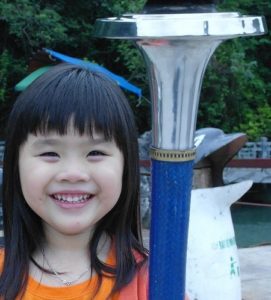
(Recent Photo of the torch being held 07 November 2012 in Vietnam)
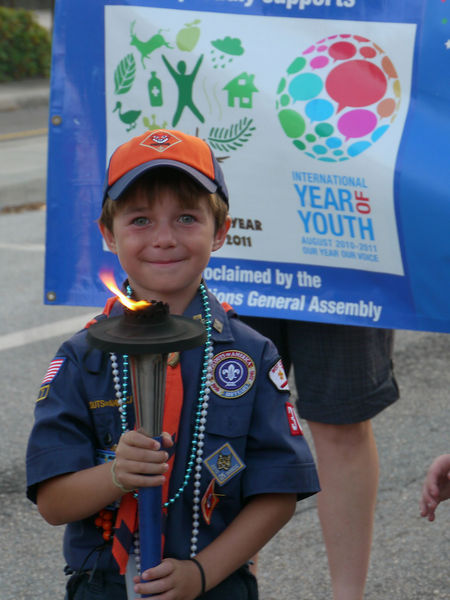
24 March 2011 in USA the torch gave much joy to participants before and during the St Petersburg “Illumine the Night” Parade.The banner for the 2011 and 2012 Oneness-Home Torch Runs in various countries carried the logo for the International Year of Forests and Year of Youth proclaimed by the UN General Assembly (partially visible in photo background))
Presentation to Guests:
Ranjana Ghose: “We would like to request Ambassador Momen to present each of our special guests with a print of Sri Chinmoy’s art work ‘Peace feeds the children’. There is also a cookie which is the form of a peace dove. It is so appropriate for tonight’s exhibition at this location and a theme that Sri Chinmoy was so very fond: of a peace bird, a peace dove and roses here.
Click on image below for larger or different resolution photo – Image:
Harmony and Peace Art Exhibit with Desmund Tutu –UN GA Building 2012
Exhibit Preview:
Sunday the 14th of October, the Exhibit was in the final stages of preparation for the official opening the following evening. Archbishop Desmund Tutu of South Africa was visiting NY and his schedule allowed him to come by for a preview of the exhibit and be with some friends from the UN community.
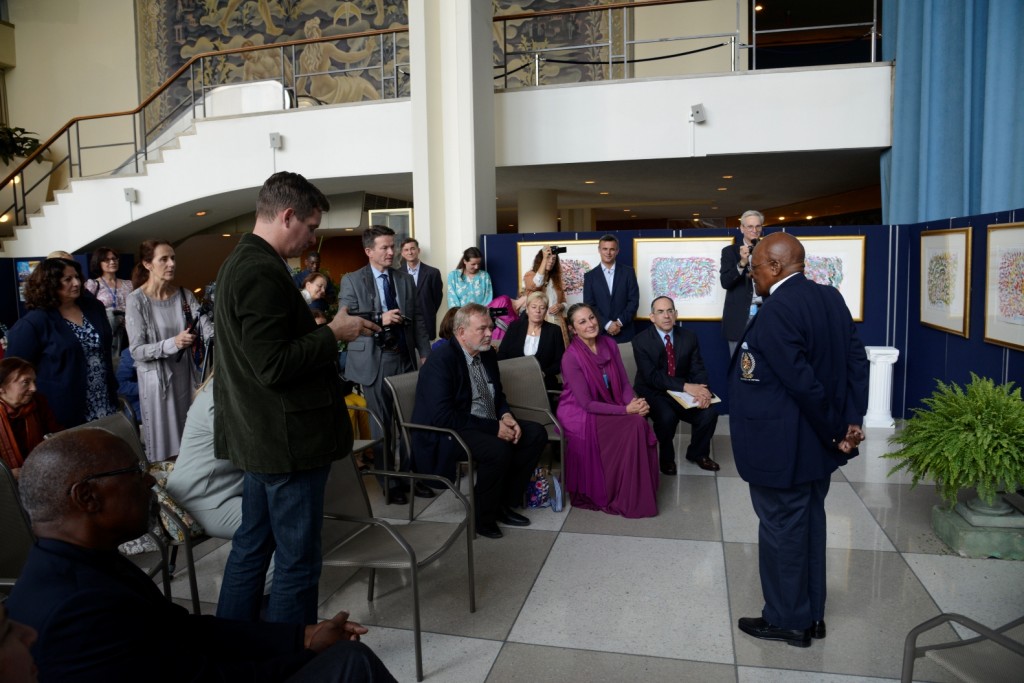
Archbishop Tutu shares some impromptu remarks about the exhibit,
The Archbishop had a long and warm relationship with the Artist Sri Chinmoy, as the quote below illustrates:
- “We are each a pool of love, compassion and serenity. Let the ripples from this pool reach to the end of the world. This is what my dear friend Sri Chinmoy did, throughout his life, for all of God’s children. God is smiling to know the immense good he has accomplished while working tirelessly to unite us as children of one Father.” – Archbishop Desmond Tutu, Archbishop Emeritus of Cape Town Chair, Truth and Reconciliation Commission Nobel Peace Laureate (1984) – (From the Exhibit notes)
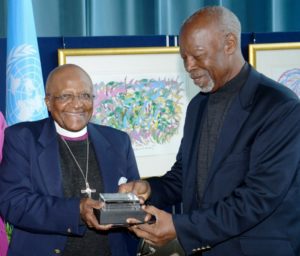
Ambassador Davidson Hepburn above (right) with Archbishop Tutu holding the award.
Ranjana Ghose speaks about the exhibit and introduces the Friend of Paintings of World Harmony award. A token of friendship, it is a painting by Sri Chinmoy titled “Unity.”, etched in glass. It uses Sri Chinmoy’s drawing of a “soul-bird”, which some came to see as his own personal signature in life.
Dr. Davidson Hepburn, presented the award. A main speaker at the exhibit opening on 15th October, Ambassador Hepburn was one of the first recipients of the Award in April in 2012 >More. He has served as President (2009 – 2011) of the General Conference of UN Educational, Scientific and Cultural Organization (UNESCO) and Permanent Representative of the Bahamas to the UN for a decade. He began attending programmes of the Peace Meditation Group at the UN in the 1970’s.
 Some the Peace Meditation Group at the UN Choir who were present perform a song the Sri Chinmoy had composed in the Archbishop’s honour.
Some the Peace Meditation Group at the UN Choir who were present perform a song the Sri Chinmoy had composed in the Archbishop’s honour.
Words by Mentor of Archbishop Desmond Tutu; Music by Sri Chinmoy December 20, 1995D
During his remarks 
He spoke of his friendship with Sri Chinmoy And the importance of continuing the work for peace.
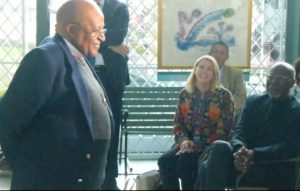
In many different arenas etc.
 Ms. Nilima Silver of the Peace Meditation Group at the UN shares with Archbishop Tutu a copy of the commemorative booklet prepared at the time of the Programme at the UN: “A Celebration of the Life of Sri Chinmoy 1931 – 2007”)
Ms. Nilima Silver of the Peace Meditation Group at the UN shares with Archbishop Tutu a copy of the commemorative booklet prepared at the time of the Programme at the UN: “A Celebration of the Life of Sri Chinmoy 1931 – 2007”)
The Archbishop’s contribution was part of the publication.
.
 Mr. D. Torphy (left) , who was a main organizer of the “Moments Peace” programme during the recent Olymic’s in London shares a light moment with the Archbishop.
Mr. D. Torphy (left) , who was a main organizer of the “Moments Peace” programme during the recent Olymic’s in London shares a light moment with the Archbishop.
http://www.youtube.com/watch?v=HZBv5Wn0nAo&feature=player_embedded
Special message from Archbishop Desmond Tutu for A MOMENT’S PEACE
Desmond Tutu had sent a personal video message (link above) that had been shown at the gathering in London and his Daughter (The Reverend Mpho A Tutu, ) spoke. (More)
The archbishop bid farewell to Dr. Hepburn and some of the others present and expressed his appreciation for all those supporting the exhibit and other activities for peace and harmony.
 Peace Meditation at the UN founder Sri Chinmoy meeting Archbishop Tutu on an earlier occasion.
Peace Meditation at the UN founder Sri Chinmoy meeting Archbishop Tutu on an earlier occasion.
 Sri Chinmoy presenting the Archbishop, Father Desmond Tutu, with the “Lifting up the World” award in 2004.
Sri Chinmoy presenting the Archbishop, Father Desmond Tutu, with the “Lifting up the World” award in 2004.
Ambassador Chowdhury visit to Exhibit 25 October 2012
 On the final day of the exhibit, Ambassador Chowdhury paid a visit to the Gallery to the delight of all the organizers.
On the final day of the exhibit, Ambassador Chowdhury paid a visit to the Gallery to the delight of all the organizers.
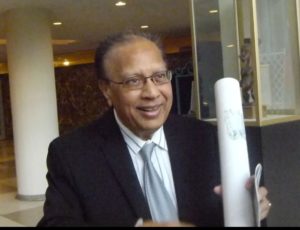 Ambassador had been a supporter of the Peace Meditation at the United Nations for decades. A close friend of the artist Sri Chinmoy and champion of a Culture of Peace, as mentioned Ambassador Chowdhury has been instrumental in many important resolutions of the General Assembly and with Security Council deliberations.
Ambassador had been a supporter of the Peace Meditation at the United Nations for decades. A close friend of the artist Sri Chinmoy and champion of a Culture of Peace, as mentioned Ambassador Chowdhury has been instrumental in many important resolutions of the General Assembly and with Security Council deliberations.
“As a true Global Ambassador of Peace, Sri Chinmoy’s vision of a oneness- world of peace and harmony, within each individual and for humanity at large, continues to be most enriching and empowering for all.” – H. E. Mr. Anwarul K. Chowdhury Under-Secretary-General and High Representative of the United Nations (2002-2007) Ambassador of Bangladesh (ret.) (- from Programme Notes)
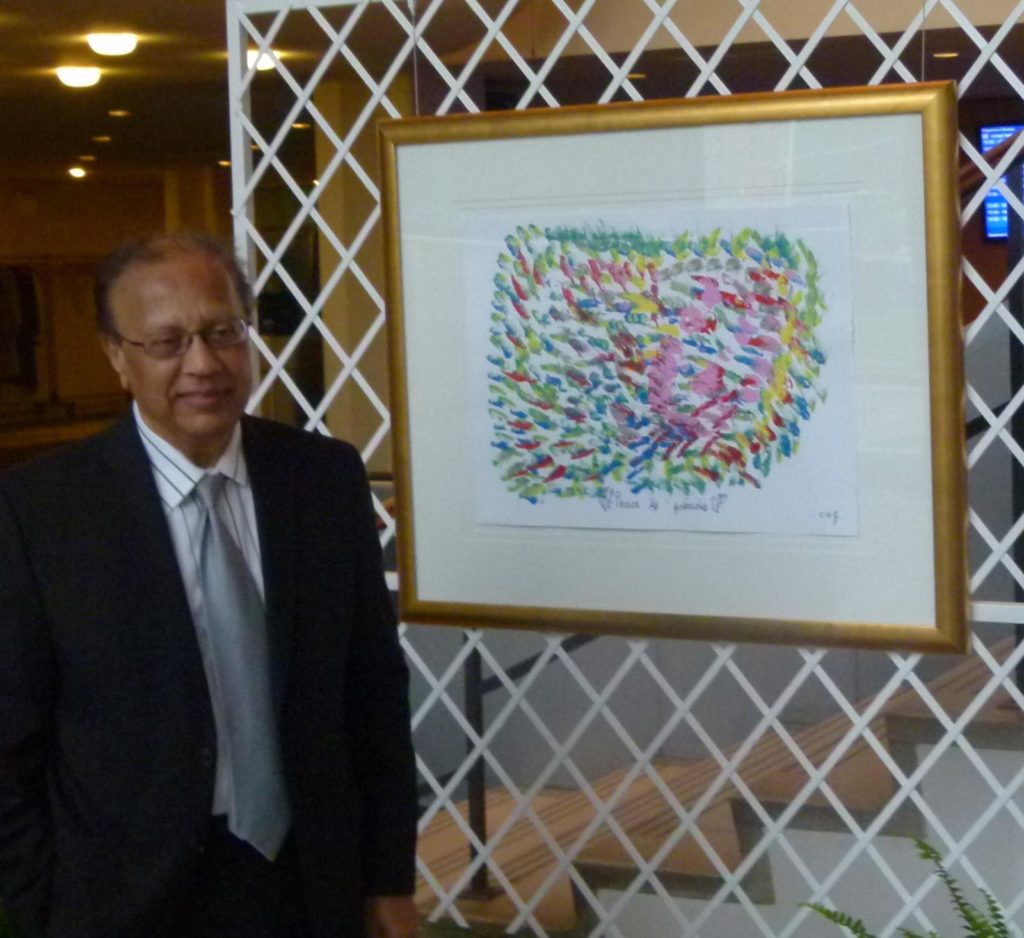
Ambassador Chowdhury looking at the ‘Peace is Precious’ painting that was published on

the back of the brochure for the “High Level Forum on the Culture of Peace”, 14 Sept. 2012.)
 Ambassador Chowdhury has been active in the 3 main parts that effectively make up the UN Community:
Ambassador Chowdhury has been active in the 3 main parts that effectively make up the UN Community:
- Secretariat of the UN, as Under-Secretary-General and High Representative etc.,
- in country Delegations, as Permanent Representative of his country and
- with Civil Society in promoting a Culture of Peace and World Harmony in many Non-Governmental Organizations (NGOs)..

An animated Ambassador Chowdhury with his great enthusiasm for expressions of Peace and Harmony.
Biographical note of the Artist: Sri Chinmoy was born in Bengal, India in 1931. Upon coming to the West in 1964, he made his home in New York City. Having travelled the world extensively, he lectured at hundreds of universities, including Harvard, Cambridge, Princeton, Yale, Stanford, Columbia, Oxford, Tokyo, Brown among others.

Sri Chinmoy Painting
Interwoven throughout the tapestry of his creative life has always been a profound appreciation and reverence for world-unity, be it expressed through his millions of soul-bird drawings or his analogies to the inspiration-bird throughout his poetry, prose and music.
During the course of his travels, Sri Chinmoy frequently offered free music concerts, himself performing on a number of musical instruments including esraj, flute, piano, harmonium and cello.
These performances were almost exclusively utilizing his own musical compositions, he being a prolific composer. Sri Chinmoy’s intention seems clear, it being none other than the hope of inspiring oneness and harmony in the world, believing that music can move people towards harmony, harmony with the self, harmony with others.
This theme is recurrent throughout all of his creative endeavours, be it through art, poetry, music, lecture, cultural performance, teaching meditation, sponsoring sporting events, or his many decades of dedication to the United Nations as a vehicle for harmony in the world. That theme is harmony, harmony within and harmony without. Harmony throughout a Oneness-World.
Sri Chinmoy on World Harmony and Peace
“We all are needed to establish world-harmony.” 1
“When we live in the heart, we feel that we all belong to one world-family.” 1
“If we can live in our hearts, (here will be peace within us and harmony in the world.” 2
“Music is the mother tongue of humanity. It is through music that we can enter into the universal harmony.” 3
“If you can create harmony in your own life, this harmony will enter into the vast world.” 4
“… enter the portals of world-harmony-paradise.” 1
“He who has neither bias nor prejudice is indeed a child of Heaven-harmony.” 1
ck of harmony comes when I feel that I know how to do something better than you. Lack of harmony is the song and dance of superiority.” 1
“Peace is the source, and from peace we get harmony.”5
“Harmony gives our minds tremendous inspiration to elevate the world.” 6
“In the searching mind, harmony blooms.” 6
“In the aspiring heart, harmony blossoms.” 6
“World-harmony Carries the message Of world peace.” 7
“Each good heart Champions the cause of world-harmony.” 8
“Harmony is the child of peace.” 9
Footnotes/bibliography
I. Sri Chinmoy Archives, Sri Chinmoy Headquarters. New York.
2. Remarks at the Dedicalion of lhe Mekong Delta as a Sri Chinmoy Peace Delta, 28 December, 1992.
3 . The Source of Music, by Sri Chinmoy, Agni Press. 1995, 1999.
4.Published in book: Service Trees .Vol.I5. poem#14,773. Agni Press 1999.
5. Unpublished quote. Sri Chinmoy Archives, Sri Chinmoy Headquarters. New York.
6. From miniature book series: Little Books of Wisdom. volume: “Harmony,” Jharna-Kala Publishing, 2000.
7. Published in book: Service·Trees, Vol. 49, poem # 48.445, Agni Press 2006. (From Ku. nl.n, Dec 2005)
8. Published in book: Service-Trees, Vol. 18, poem # 17,765, Agni Press, 2000.
9. Remarks to local officials al World Harmony Run ceremony in Kuantan, Malaysia, New Years Day 2006.
For booklet from event in pdf format: 2012-oct-15-25-un-wh-paint-booklet





